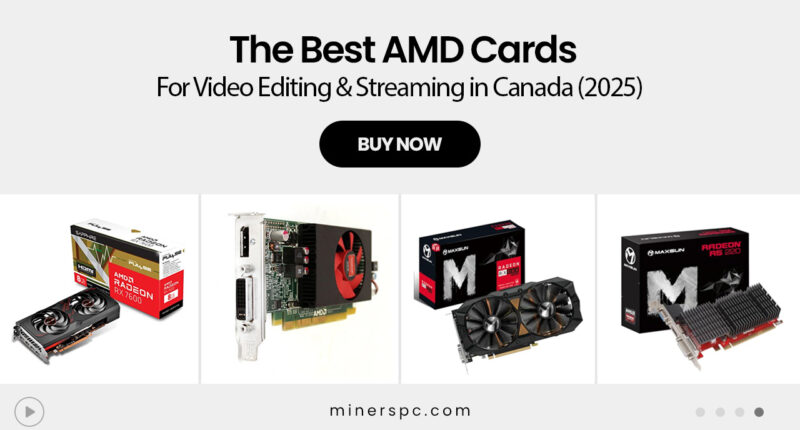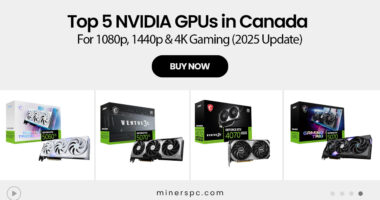When it comes to video editing and streaming in 2025, having the right GPU isn’t just a bonus—it’s essential. Whether you’re crafting 4K YouTube content in Toronto, livestreaming gameplay from your rig in Vancouver, or editing cinematic reels in Montreal, your graphics card is doing far more than pushing pixels. AMD Radeon GPUs have carved out a strong reputation in Canada for their creator-friendly performance, driver stability, and affordability. But which cards are really worth your attention?
In this guide, we’ll explore the best AMD GPUs that balance power, encoding performance, and value to help Canadian content creators and streamers get the most out of every render, stream, and frame.
Why AMD for Content Creation?
For Canadian creators, AMD offers compelling reasons to stick with Radeon:
- Smart Access Memory (SAM): Better bandwidth utilization between CPU and GPU.
- AV1 and H.265 Encoding: Perfect for high-quality streaming and efficient exports.
- Support for Open-Source Tools: Ideal for Linux users and DaVinci Resolve editors.
- More VRAM for Less: A huge plus when working with 4K timelines, motion tracking, or multi-layered VFX.
Best Overall Performer: Sapphire Pulse RX 7800 XT (16GB, RDNA 3)
For serious editors and streamers, the Sapphire 11330-02-20G Pulse RX 7800 XT is a productivity powerhouse. It comes equipped with 16GB of GDDR6 VRAM, giving you headroom for editing 6K timelines or running Blender alongside OBS Studio.
The RDNA 3 architecture also delivers AV1 hardware encoding, which drastically reduces CPU load while livestreaming on platforms like Twitch and YouTube. This is crucial for maintaining smooth gameplay and professional-quality stream output simultaneously.
If you’re editing with Adobe Premiere Pro or DaVinci Resolve, expect snappy timeline performance and smooth playback—even with effects-heavy projects.
Solid Mid-Range Pick: Sapphire RX 7600 (8GB, RDNA 3)
If you’re a solo content creator or a mid-level streamer upgrading from integrated graphics or older hardware, the Sapphire RX 7600 Pulse is a highly capable solution.
Its 8GB GDDR6 VRAM is enough for 1080p and 1440p editing workflows, and its support for AV1 encoding ensures crisp, low-bitrate video streaming. Canadian creators working in smaller studios or on-the-go setups will appreciate its power efficiency and quiet operation.
Pair it with a Ryzen 7000 series CPU and Smart Access Memory for an excellent performance uplift without breaking the bank.
Entry-Level Streaming: MAXSUN Radeon RX 580 (8GB)
Don’t let the RX 580’s age fool you—it’s still very relevant in 2025 for beginners in streaming and editing. The MAXSUN RX 580 8GB delivers dependable performance for HD content creation, especially when working with platforms like OBS, Shotcut, or Lightworks.
It’s not designed for cutting-edge 4K workflows, but for recording and editing 1080p content, or doing light livestreaming with a dual-PC setup, it holds its own. It’s also surprisingly effective for creators using Linux-based editing suites, thanks to mature open-source driver support.
For Compact or Budget Builds: MAXSUN RX 550 4GB GDDR5 ITX
For those who need a low-profile card that still supports solid encoding features, the MAXSUN RX 550 ITX is a hidden gem. It’s perfect for small form-factor builds where space and power are limited—think bedroom streamers or mobile content rigs.
While it lacks AV1 support, it still handles H.264/H.265 encoding well enough for basic streaming and video editing. It’s also a reliable GPU for offloading renders in software like HitFilm Express or Camtasia.
Reliable Legacy Option: Radeon R5 and HD Series
Canadian creators on an ultra-tight budget or working with refurbished systems might consider options like:
- MAXSUN Radeon R5 220 (1GB or 2GB) – Great for basic video playback and editing in SD or low-bitrate HD projects.
- AMD Radeon R5 240 – A very minimal option for older editing software or business-level tasks like training videos and presentations.
- Radeon HD 7670 & HD 6770 (4GB DDR5) – These can still handle basic 720p/1080p cuts in tools like OpenShot or Kdenlive, though they lack support for newer encoding standards.
These cards shouldn’t be your first choice for modern workflows, but they can still get the job done in education or backup setups.
Premium Touch for Multitaskers: GIGABYTE RX 7600 Gaming OC (8GB)
The GIGABYTE GV-R76GAMING OC-8GD offers excellent thermal performance with its triple-fan WINDFORCE system, keeping temperatures in check even during long editing sessions or extended streams.
Its factory overclock and RDNA 3 architecture deliver extra power for creators juggling multiple apps—like editing in Premiere while rendering motion graphics in After Effects.
If you’re building a mid-to-high-end workstation in Canada, this GPU is worth a second look, especially for those who demand stability and silent operation during intensive workloads.
Creator Tip: Optimize OBS & DaVinci Resolve with AMD Hardware
Whether you’re streaming gameplay or editing wedding footage, a few simple optimizations can dramatically boost performance:
- In OBS Studio, switch to H.265 (HEVC) or AV1 hardware encoding for reduced CPU load and superior quality.
- In DaVinci Resolve, enable GPU decoding and encoding under Preferences > System > Decode/Encode.
- Use AMD’s Adrenalin Software to manage fan curves, record with Radeon ReLive, or tweak performance profiles based on your editing workload.
These steps ensure that you get every bit of value out of your Radeon GPU, especially in high-stakes client projects or when streaming live.
Final Thoughts: AMD Cards That Empower Canadian Creators
From students editing TikTok reels to professionals streaming 4K gameplay, AMD has created a lineup of graphics cards that hit nearly every content creation sweet spot. Whether you’re chasing buttery 60fps video playback or minimizing encoding times during final renders, there’s a Radeon GPU that fits your workflow and budget.
Each of the cards listed below brings something unique to the table — from powerful encoding support to compact design and dependable legacy performance. The key is choosing the one that aligns with your creative goals today while keeping an eye on where you’re headed tomorrow.















![Best Prebuilt PCs in Canada for Work, School & Gaming [2025 Guide]](https://www.minerspc.com/wp-content/uploads/2025/07/best-prebuilt-pcs-in-canada-for-work-school-gaming-2025-guide-260x140.jpg)


